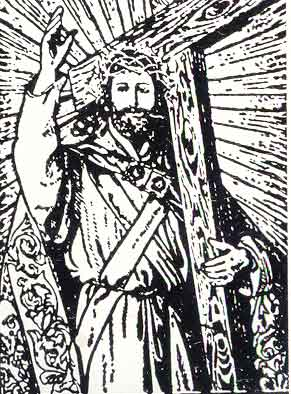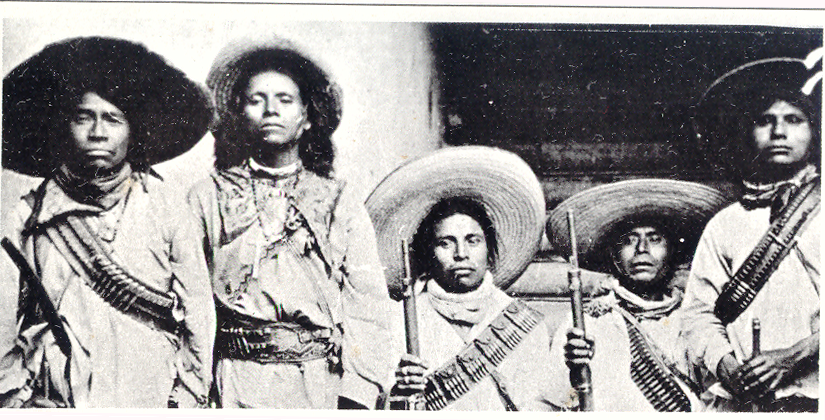
 |
The Cristero Rebellion was
one of the last major, armed uprisings in the aftermath of the Revolution.
This rebellion cannot be easily categorized as a reactionary movement
against the revolutionary regime. It is true that the upper echelons of
the Catholic Church, by suspending all religious services, are partly
responsible for provoking the rebellion, and that historically they had
aligned themselves with the conservative élites. But the antagonistic
manner in which President Calles enforced the anti-clerical articles of
the Constitution forced the high clergy's hand. Although initially the
Church had encouraged the rebellion, once the war was under way, the high
clergy of the Church distanced itself from the movement, leaving it floundering
without any direction. The members of the clergy who were directly involved
in the conflict were typically local priests, and the people who formed
the populist groups that rose up in arms were a mix of middle-class Mexicans,
campesinos, devout Catholics who simply wanted to be able to practice
their religion, as well as some more conservative elements who had been
on the losing side during the Revolution. The corridos that were composed
during the war reflect the pluralism of factions that were involved, and
the sometimes precarious alliances that were formed.
 |
Huichol Warriors during the Cristiada
El Corrido de la
Convención narrates an event that took place in 1925 before
the hostilities began. This corrido has the tone of government propaganda
in its highly idealized portrait of Plutarco Elías Calles. He appears
before a crowd of the citizens of Jerez, Zacatecas and asks them "why
have you closed your temple? I haven't come to take your religion away,
let each person believe as he wishes." El Corrido de Toral
tells how in 1928, the zealous young Catholic, José Toral, in his
fervent desire to defend his religion against an atheistic government,
murdered President-elect Álvaro Obregón in a public restaurant.
Valentín de la Sierra, the best-known of the corridos
of the Cristiada, tells the story of a Cristero leader and spy who was
captured by an agrarista battalion, and after betraying the cause by informing
on the movements of Cristero troops, he was executed by federal forces.
Another corrido about betrayal within the Cristero ranks is the Corrido
de Victoriano Ramírez, "El Catorce." The protagonist
of this corrido is the popular, but controversial commander of a Cristero
regiment in Jalisco. As a result of rivalries and jealousies among the
leaders of the movement in that state, Victoriano ends up being betrayed,
and later murdered by his fellow Cristeros. From the other side of the
battlefield comes the Corrido de Quirino Navarro. The protagonist
in this corrido is the mayor of the city of Tepatitlán, Jalisco,
who remains loyal to the Calles government. He ends up becoming the commander
of a battalion of agraristas and he takes part in several battles in which
he defends his city from attacks by the Unión Popular, one of the
Cristero groups. Even the end of the Cristero rebellion produced a corrido
to narrate how the Mexican government and the Catholic Church managed
to come to an agreement, El Arreglo Religioso, which gives
a summary of events that happened before and during the conflict. It also
applauds Emilio Portes Gil for his role in bringing an end to the aggressions.
One very intriguing point is that though
no composer is cited on this version of El Arreglo Religioso,
a version of this song in an earlier recording (July 1929, Columbia Records,
New York, NY) by a group calling itself Los Cancioneros de Sonora, listed
the composer as "Yucho." This was a pseudonym for Augusto Alberto
Cárdenas Pinelo, one of the great composers of popular music in
Mexico during the early part of the 20th Century. Also known as, Guty
Cárdenas, he was born in Mérida, Yucatán on December
2, 1905. Guty Cardenas was called the el ruiseñor yucateco or
the Yucatecan Nightingale for his beautiful voice and lyrical compositions,
and was one of the most brilliant young composers of the period before
his untimely murder at the age of 27 in Mexico City on April 5, 1932.
According to Dr. James R. Nicolopulos, Professor of Spanish and Portuguese
at the University of Texas at Austin, "Cárdenas was just one
of several well-established, mainstream commercial composers that contributed
pro-government politically oriented propaganda corridos during this period.
One example is the Corrido del agrarista that was written
by Lorenzo Barcelata and E. Cortazar. Another would be the Corrido
del Petroleo - fruit of the fecund pen of Felipe Valdez Leal."
It is interesting to note this complex connection
between the popular songwriters, like Cárdenas, during the years
of the Cristiada and various compositions that celebrate the triumphant
political forces that forged the institutionalization of the Mexican Revolution
in the Partida Institucional Revolucionario, founded by Calles in 1929.
Cárdenas wrote not only this corrido but also one commemorating
the death of Obregón, also recorded by Los Cancioneros de Sonora.
The connection of a group of Sonoran musicians and these notable and very
pro-government songs cannot be mere coincidence. Since the patronage of
ancient Greek theatre to glorify the state, we have seen how money, political
power, patronage and the arts have worked in tandem to create persuasive
hegemonic statements. But the important innovation here would the confluence
of technology, politics and art as it developed during the years of the
Cristiada when radio broadcasting and the recording industry took the
corrido from the folkloric backburner where it had developed in relative
obscurity and transformed it into a polished product created by professional
composers and interpreted by accomplished musicians in easy to understand
rhetorical segments of about three minutes. The government could hardly
fail to notice this development, nor miss the obvious advantage of getting
their message out via these easily consumed cultural products. Also of
note is that Obregón and Calles, the primary forces who consolidated
Mexican national power at the end of the Revolutionary period and created
the PRI as the mechanism of state control, were known as the "Men
of Sonora." That a group of Sonoran musicians, Los Cancioneros de
Sonora, would record songs by a composer of Guty Cardenas' stature in
the Mexican popular music scene with a pro-government message is difficult
to ascribe to mere chance. Perhaps as many scholars have maintained, this
era marked the beginning of the decadence of the corrido through commercialization,
but also, it could be argued that this period initiated the corrido's
maturation from a fairly unsophisticated, rural art form into a slick,
urban cultural product: a shift that reflected the incipient change of
the very structure of modern society from rural to urban, as well as becoming
a political tool that reflected the ideas of those at the pinnacle of
power. Pancho Villa was renowned as the first Mexican leader to understand
the importance of the mass media, but his example of canny media manipulations
for propaganda purposes did not go unheeded by his rivals for power.
Vicente Mendoza believes that the corridos
of the Cristiada represent one of the last phases of development of the
traditional corrido before the commercialization through radio, phonograph,
and films lead to its decadence. (Mendoza, pp. xv-xvi) This is something
that scholars will debate for the foreseeable future, however we can surely
accept that these songs are a direct and visceral response to social situations
that typically engender classic corridos. They reflect the ambivalence
that many Mexicans felt toward the major political factions, the Church
and State, who were locked in a power struggle with very high stakes.
And though some of the songs are focused on a specific political ideology,
all of these corridos express the community values of a people who were
being persecuted by what they perceived to be unsympathetic hegemonic
forces. The songs make liberal use of traditional elements found in corridos
from other sub-genres: corridos de fusilamientos, lamentos de prisioneros,
héroes de conflicto intercultural y bandoleros sociales. In most
cases, however, the corrido of the Cristiada reflects the classic model:
the heroic protagonist is engaged in a life or death struggle, he suffers
the intrigues and betrayals of those that he thought were his friends,
this treachery leads to the protagonist's downfall, all of this in the
context of an active "ballad tradition." (Paredes, p. 232) In
some of the corridos there is the idealistic devotion to a cause, whether
it be freedom of religion, the liberal ideals of the Revolution, or the
defense of one's town, which, in spite of the violent means to an end,
is inevitably seen as just and a strong reinforcement of community standards.
--Written by Elizabeth Garcia and Mike McKinley, May 2004


